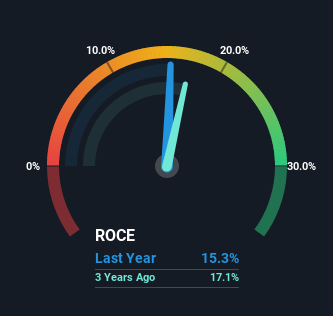Investors Met With Slowing Returns on Capital At Target (NYSE:TGT)
If we want to find a stock that could multiply over the long term, what are the underlying trends we should look for? Amongst other things, we'll want to see two things; firstly, a growing return on capital employed (ROCE) and secondly, an expansion in the company's amount of capital employed. Basically this means that a company has profitable initiatives that it can continue to reinvest in, which is a trait of a compounding machine. So, when we ran our eye over Target's (NYSE:TGT) trend of ROCE, we liked what we saw.
Return On Capital Employed (ROCE): What Is It?
For those that aren't sure what ROCE is, it measures the amount of pre-tax profits a company can generate from the capital employed in its business. The formula for this calculation on Target is:
Return on Capital Employed = Earnings Before Interest and Tax (EBIT) ÷ (Total Assets - Current Liabilities)
0.15 = US$4.9b ÷ (US$56b - US$24b) (Based on the trailing twelve months to October 2022).
Thus, Target has an ROCE of 15%. In absolute terms, that's a pretty normal return, and it's somewhat close to the Multiline Retail industry average of 13%.
Check out our latest analysis for Target
Above you can see how the current ROCE for Target compares to its prior returns on capital, but there's only so much you can tell from the past. If you're interested, you can view the analysts predictions in our free report on analyst forecasts for the company.
The Trend Of ROCE
While the current returns on capital are decent, they haven't changed much. The company has consistently earned 15% for the last five years, and the capital employed within the business has risen 25% in that time. 15% is a pretty standard return, and it provides some comfort knowing that Target has consistently earned this amount. Stable returns in this ballpark can be unexciting, but if they can be maintained over the long run, they often provide nice rewards to shareholders.
Another thing to note, Target has a high ratio of current liabilities to total assets of 43%. This can bring about some risks because the company is basically operating with a rather large reliance on its suppliers or other sorts of short-term creditors. Ideally we'd like to see this reduce as that would mean fewer obligations bearing risks.
In Conclusion...
The main thing to remember is that Target has proven its ability to continually reinvest at respectable rates of return. And long term investors would be thrilled with the 201% return they've received over the last five years. So while investors seem to be recognizing these promising trends, we still believe the stock deserves further research.
One final note, you should learn about the 4 warning signs we've spotted with Target (including 1 which can't be ignored) .
While Target isn't earning the highest return, check out this free list of companies that are earning high returns on equity with solid balance sheets.
Have feedback on this article? Concerned about the content? Get in touch with us directly. Alternatively, email editorial-team (at) simplywallst.com.
This article by Simply Wall St is general in nature. We provide commentary based on historical data and analyst forecasts only using an unbiased methodology and our articles are not intended to be financial advice. It does not constitute a recommendation to buy or sell any stock, and does not take account of your objectives, or your financial situation. We aim to bring you long-term focused analysis driven by fundamental data. Note that our analysis may not factor in the latest price-sensitive company announcements or qualitative material. Simply Wall St has no position in any stocks mentioned.
Join A Paid User Research Session
You’ll receive a US$30 Amazon Gift card for 1 hour of your time while helping us build better investing tools for the individual investors like yourself. Sign up here

 Yahoo Finance
Yahoo Finance 
